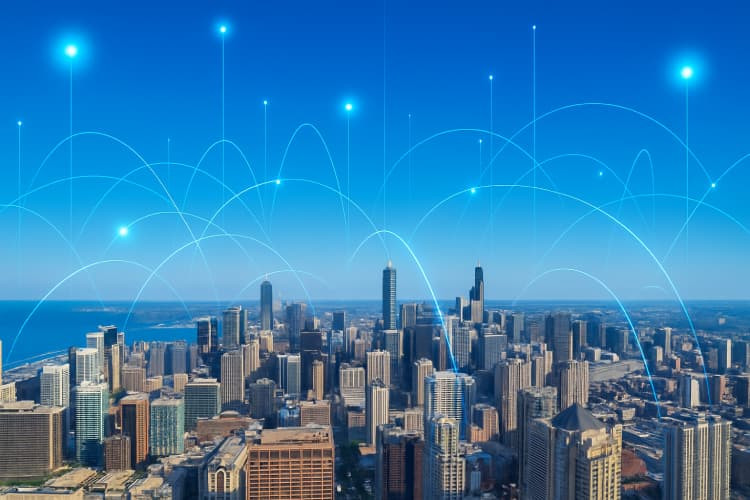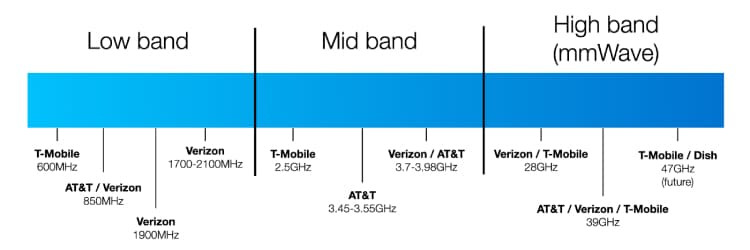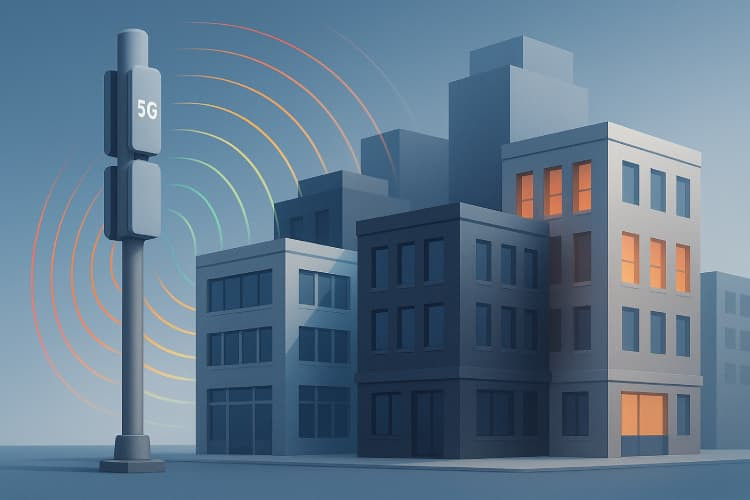5G Facts and Myths: The Real Story Behind the Tech
Insights | 11-08-2025 | By Gary Elinoff

Key Takeaways about 5G – The Greatest Story Ever Sold:
- IMEC has just developed an RF chip that can operate at 13 GHz
- Despite the hype, 5G networks do not operate at the ultra-high frequencies being touted
- It is 5 G's network architecture that is the key to its efficacy
- Public 5G networks get all the publicity, but it is private 5G networks that are the real story
Introduction
A recent Electropages article described a transistor from IMEC that can operate at 13 GHz. This device, based on Gallium Nitride (GaN) mounted on a Silicon substrate (editor, please provide link to my 7/1/25 article), isn't the fastest available. However, it is the only technology available at a price point remotely appropriate to even high-end consumer handsets that cost in the range of $1,000.
And yet, one can barely open a magazine or click on a link without seeing ads from carriers touting 5G devices operating at 20 GHz and better.

5G Spectrum: Image source: 5G Store
And, a hype alert. A one millimeter wavelength corresponds to approximately 300 GHz, not 28 GHz. However industry parlance "defines" millimeter wavelengths as being from 1 to 10 millimeters. 10 mm corresponds to 30 GHz, so by this "definition", 47 GHz or 39 GHz would "qualify".
Yes, such devices do exist, but even if a consumer decides to pay the price of $1,000 or more, there are issues severely limiting utility. But 5G isn't just hype, and it does have its place even now, but, as we'll see, ordinary consumers aren't the true beneficiaries.
Problems with High-Frequency 5G Transmission
Free Space Path Loss
It's well known that an RF signal weakens by the square of the distance between transmission and reception. Less well known is that the signal also weakens by the square of the transmission frequency. The actual formula for Free Space Path Loss (FSPL) is:
Free Space Path Loss (FSPL) formula:
Or, putting it in words, loss is proportional to not only the square of the distance, but also the square of the frequency. As such, with distance kept steady, the signal strength loss is quadrupled if the transmission frequency is doubled.
What this means, in practice, is that the signal strength of a radio signal decreases with its frequency. This is in addition to the signal decrease due to distance.
Obstruction and Interference
High frequency radio signals, including high speed 5G transmissions, can be attenuated or even blocked by physical barriers, such as windows, walls or building structures. The effects are much more pronounced at higher frequencies than at lower frequencies.

This is a very significant issue for 5G. It means that to affect a 5G system, there needs to be a higher concentration of 5G towers to cover a given area, as compared to what would be needed for lower-frequency 4G signals.
Latency
As described by EPB[1], "latency measures how many milliseconds (ms) it takes for data to travel from one point to another and back again. Imagine shouting across a canyon and waiting for your echo to return—the shorter the wait, the smoother and more natural the experience." A great advantage that 5G enjoys over 4G is the potential for much lower latency.
Latency is strongly influenced by the frequency of the radio wave carrying the information. Simply put, the higher the frequency, the more information the radio channel can carry. Larger data channels translate into shorter delays. But the flip side to higher frequencies is that they are subject to interference, necessitating the need for more cellular repeaters.
How 5G Effects Lower Latency
- MIMO – Multiple Inputs and Outputs. Again, as described by EPB, "Imagine adding extra lanes to a highway so more cars (data) can move at the same time without causing traffic jams. Massive MIMO uses many antennas to send and receive data simultaneously, allowing 5G networks to handle more users and devices without slowing down, even during busy times."
- Edge Computing. Processing a user's data requests closer to the user. Less time is taken up traveling to very remote data centers.
- Network Slicing, aka customized connections. The network is divided into slices, with applications that require minimal latency, such as emergency services, receiving their own highly dedicated, fast and reliable data lanes.
A cautionary note – 5G can be as low 1 to 10 milliseconds(ms), far eclipsing 4 G's 50 to 100 ms. But, nothing beats a fiber optic connection, where latency can actually be lower than 1 ms. And while it may seem contradictory, 5G towers themselves are often interconnected via fiber optic cables, minimizing the RF pathway and further reducing latency.
Applications of 5G
A thirteen-year-old gamer, with the reflexes of a cat, can play a video game from their smartphone with latency so low that even they can't notice it on a 5G network. But that gamer must be located in close proximity to a 5G tower. Additionally, video conferencing and streaming without annoying delays can also be enjoyed.
It is, however, private 5G networks, rather than the public networks that have been described, that provide the real utility of 5G.
Private 5G Networks
A private 5G network is a cellular network devoted specifically to the needs of an enterprise. Use cases include manufacturing facilities, healthcare, remote mining or agricultural projects and military applications.
And yes, private 5G networks can also be deployed in large venues such as athletic arenas and concert halls, where the huge concentration of viewers and attendees, all requiring cellular connectivity, would overwhelm any conceivable 4G network.
Private 5G Networks for Industry
A private 5G network from Siemens[2] starts with a central core. And, as in the case for public 5G networks, the central core is connected to the 5G "towers" via fiber optic cables. That's the "secret sauce", because as mentioned earlier, as fast as 5G is, it can never be as fast as cable. As illustrated below, the towers are distributed throughout the factory floor, providing super-fast connectivity with all the manufacturing subsystems.
One of the many advantages here is that only the towers are encumbered by cables; all the other components, however many there might be, can be freely moved about the manufacturing campus, and they will still be able to connect to one of the "towers". This allows the factory to easily adapt to changes, without the hassle and expense of rewiring.
Industrial Private 5G Network. Image source: Siemens Video (1 min:14 seconds)
This enables near-instantaneous machine-to-machine communication and collaboration between mobile robots.
Another tremendous advantage here is that information is private; it is not shared on a public network, enabling enhanced security. As mentioned, the private 5G network can be tailored to the very specific requirements of each industrial site.
Other Applications of Private 5G Networks
There are many other applications of 5G private networks, including healthcare. As described by Accelleran[3], "Healthcare environments are complex, requiring unwavering accuracy, swift response times, and adaptability. These Private 5G networks bring the bandwidth and dependable connectivity that enables healthcare providers to elevate the delivery standards of their service."
The advantages of private 5G networks for healthcare are quite similar to those for manufacturing.
- High-speed data transmission
- Enhanced security and privacy
- Seamless connectivity across facilities, wherever a local 5G radio node connected by fiber is installed
- The flexibility of private 5G networks allows for the integration of vast numbers of Internet of things (IoT) devices, including wearable health monitors and sensors.
Aside from manufacturing and healthcare, private 5G networks will find application, with similar benefits, in:
- Airports
- Logistics
- Smart cities
- Agriculture
- Mining
- Utilities
And the list goes on.
Wrapping Up
So we see that 5G incorporating "millimeter waves" are only possible using exotic techniques that are far too expensive for general use. The recent announcement of the IMEC 13 GHz chip highlights the fact.
The real advantages of 5G include MIMO, edge computing and network slicing. These are best applied in private networks, and the benefits here are in reality quite substantial.
Challenges and Opportunities
In regard to very high frequency wireless networks, nobody said it better than Star Trek's fictional Chief Engineer, Commander Montgomery Scott, to wit: "Captain, I cnnae change the laws of physics". So, barring some very fundamental advances in theoretical physics, millimeterWave radio transmission will be subject to FSPL. Additionally, transmission at those ultra-high wavelengths will be all too easily disrupted by buildings, glass and other common obstacles.
But that doesn't mean that millimeterWaves won't prove to be useful in some applications of 5G networks where huge amounts of data needs to passed with extremely low latency, specifically for short distances with unobstructed pathways.
The challenge will be to develop transistors that can amplify RF at frequencies even beyond what IMEC's remarkable chip is capable of.
References
- 5G Low Latency And Why It's Lower Than 4G. EPB
- How do Private Industrial 5G Networks work? Siemens Knowledge Hub
- The Future of Healthcare with Private 5G Networks. Accelleran
Glossary of Terms
- Latency. For 5G, the time it takes to send a radio signal, perhaps to a cellular tower, and receive a response.
- Free Space Path Loss (FSPL). The reduction of a radio wave's signal strength as it travels through an unobstructed line-of-sight pathway from transmitting and receiving antennas.

